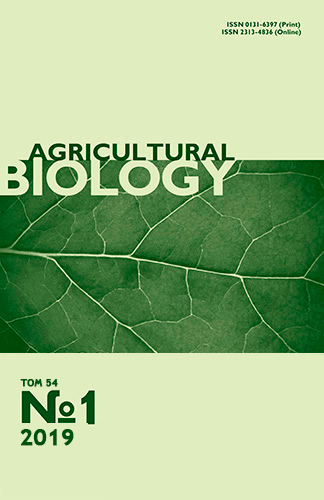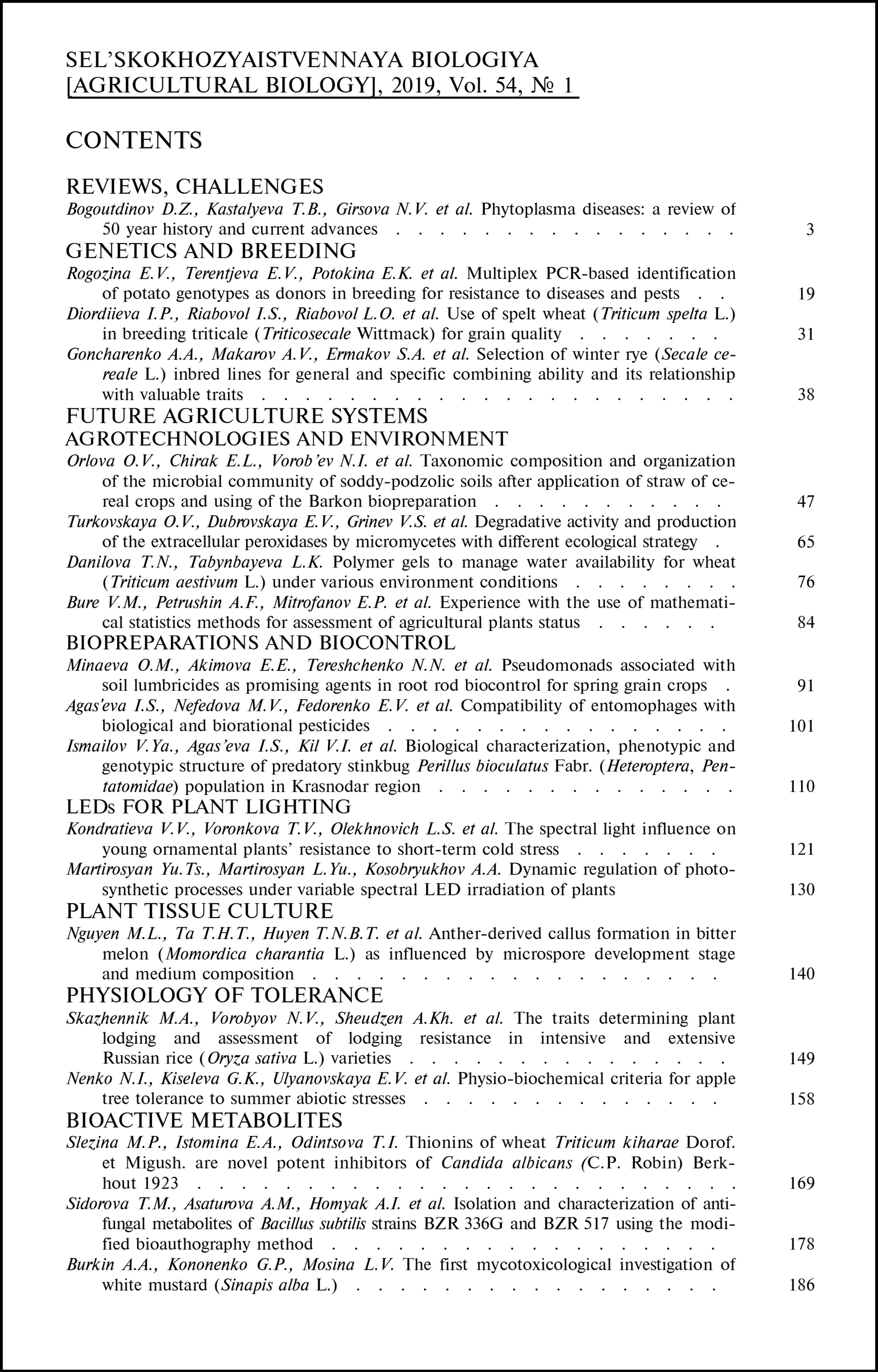doi: 10.15389/agrobiology.2019.1.186eng
UDC 632.4:615.9
THE FIRST MYCOTOXICOLOGICAL INVESTIGATION
OF WHITE MUSTARD (Sinapis alba L.)
A.A. Burkin1, G.P. Kononenko1, L.V. Mosina2
1All-Russian Research Institute of Sanitary, Hygiene and Ecology — Branch of Federal Science Center Skryabin and Kovalenko All Russian Research Institute of Experimental Veterinary RAS, 5, Zvenigorodskoe sh., Moscow, 123022 Russia, e-mail kononenkogp@mail.ru (✉ corresponding author), aaburkin@mail.ru;
2Timiryazev Russian State Agrarian University—Moscow Agrarian Academy, 49, ul. Timiryazevskaya, Moscow, 127550 Russia, e-mail mosina.l.v@yandex.ru
ORCID:
Burkin A.A. orcid.org/0000-0002-5674-2818
Mosina L.V. orcid.org/0000-0003-2120-0389
Kononenko G.P. orcid.org/0000-0002-9144-615X
Received July 7, 2018
Crops widely represented on cultivated lands and often found in natural botanical formations have attracted increasing attention of researchers in recent years. This is due not only to their economic importance, but also to the high value of both experimental facilities that allow studying the features of the formation of the diversity of biocenotic connections and ecological equilibria. According to modern concepts, a complex of secondary substances in plants is increasingly seen as a joint product of their associations with microorganism communities, mainly microscopic fungi (S. Kusari et al., 2012). Recently, Russian researchers performed the first cycle of studies aimed at a comparative study of the content of mycotoxins in cereals and legumes in industrial crops and in the natural habitat (G.P. Kononenko et al., 2015; A.A. Burkin et al., 2017). In the present work, we obtained first information about the nature of the contamination of cruciferous plants with toxic metabolites of microscopic fungi, revealed for the first time differences in their localization in vegetative and generative organs, as well as changes accompanying the full development cycle. The aim of this work was to study the composition and content of mycotoxins in the white mustard (Sinapis alba L.), a cultivated plant of wide application, which also easily populates agricultural land and occurs in natural grass stands. For analysis, we used overground parts of plants and their organs (leaves, stems, flowers, pods) collected in the white mustard monoculture in 2017 during distinct phases of plant development. These phases were i) the beginning of the growing season after the completed formation of plant basic structure, ii) mass flowering, iii) the formation of green pods and iv) full ripening. The mycotoxins determined by the enzyme-linked immunosorbent assay were T-2 toxin (T-2), diacetoxyscirpenol (DAS), deoxynivalenol (DON), zearalenone (ZEN), fumonisins (FUM), alternariol (AOL), aflatoxin B1 (AB1), sterigmatocystin (STE), roridin A (ROA), cyclopiazonic acid (CPA), emodin (EMO), ochratoxin A (OA), citrinin (CIT), mycophenolic acid (MPA), PR toxin (PR) and ergot alkaloids (EA). AOL, CPA, and EA were found in the mycotoxin complex of Sinapis alba organs during vegetation period, and all other metabolites were absent or detected sporadically. The very moderate accumulation of mycotoxins in this plant is a useful economic property, and previously no such slightly contaminated cultures were detected among examined cereals and legumes. During the vegetation of the mustard, the composition of mycotoxins and the quantitative ratios between them were generally stable, but the content of AOL and CPA decreased as the plant matured. Mass flowering was accompanied by the appearance in the plant of fusariotoxins DAS, DON, FUM, which were not detected in the next phase (pod formation). In experiments with individual organs of Sinapis alba, multiple and intense flower contamination with all analyzed mycotoxins, complete absence of fusariotoxins in green and ripe pods, as well as increased levels of AOL accumulation in leaves compared with stems are established for the first time. Possible causes of this phenomenon, the scientific and practical significance of new information on the degree of contamination, seasonal dynamics and accumulation of mycotoxins in this plant, as well as the prospects for further scientific research are discussed.
Keywords: white mustard, Sinapis alba, mycotoxins, T-2 toxin, diacetoxyscirpenol, deoxynivalenol, zearalenone, fumonisins, alternariol, aflatoxin B1, sterigmatocystin, roridin A, cyclopiazonic acid, emodin, ochratoxin A, citrinin, mycophenolic acid, PR toxin, ergot alkaloids, enzyme immunoassay.
REFERENCES
- Burkin A.A., Kononenko G.P. Mycotoxin contamination of meadow grasses in European Russia. Agricultural Biology [Sel’skokhozyaistvennaya Biologiya], 2015, 50(4): 503-512 CrossRef
- Kononenko G.P., Burkin A.A., Gavrilova O.P., Gagkaeva T.Yu. Fungal species and multiple mycotoxin contamination of cultivated grasses and legumes crops. Agricultural and Food Science, 2015, 24(4): 323-330 CrossRef
- Burkin A.A., Kononenko G.P., Gavrilova O.P., Gagkaeva T.Yu. Mycotoxins in the legumes of natural fodder of the European Russia. Agricultural Biology [Sel’skokhozyaistvennaya Biologiya], 2017, 52(2): 409-417 CrossRef
- Kusari S., Spiteller M. Metabolomics of endophytic fungi producing associated plant secondary metabolites: progress, challenges and opportunities. In: Metabolomics. U. Roessner (ed.). In Tech, London: 2012, 241-266.
- Seregin I.V. Uspekhi biologicheskoi khimii, 2001, 41: 283-300 (in Russ.)
- Katepa-Mupondwa F., Raney J.P., Rakow J. Recurrent selection for increased protein content in yellow mustard (Sinapis alba L.). Plant Breeding, 2005, 124(4): 382-387 CrossRef
- Fu Y.B., Gugel R., Katepa-Mupondwa F. Genetic diversity of Sinapis alba germplasm as revealed by AFLP markers. Plant Genetic Resources, 2006, 4(2): 87-95 CrossRef
- Klóska ?., Cegielska-Taras T., Pi?tka T. Regeneration capacity of selected genotypes of white mustard (Sinapis alba L.). In Vitro Cell. Dev. Biol.-Plant, 2012, 48(2): 180-188 CrossRef
- Fu Y.B., Cheng B., Peterson G.W. Genetic diversity analysis of yellow mustard (Sinapis alba L.) germplasm based on genotyping by sequencing. Genet. Resour. Crop Evol., 2014, 61(3): 579-594 CrossRef
- Roshchina V.V. Biomediatory v rasteniyakh. Atsetilkholin i biogennye aminy [Biomediators in plants. Acetylcholine and biogenic amines]. Pushchino, 1991 (in Russ.)
- Golovkin B.N., Rudenskaya R.N., Trofimova I.A., Shreter A.I. Biologicheski aktivnye veshchestva rastitel'nogo proiskhozhdeniya [Bioactive substances of plant origin]. Moscow, 2001 (in Russ.)
- Popova I.E., Morra M.J. Simultaneous quantification of sinigrin, sinalbin, and anionic glucosinolate hydrolysis products in Brassica juncea and Sinapis alba seed extracts using ion chromatography. J. Agric. Food Chem., 2014, 62(44): 10687-10693 CrossRef
- Vastenhout K.J., Tornberg R.H., Johnson A.L., Amolins M.W., Mays J.R. High-performance liquid chromatography-based method to evaluate kinetics of glucosinolate hydrolysis by Synapis alba myrosinase. Analytical Biochemistry, 2014, 465: 105-113 CrossRef
- Javidfar F., Cheng B. Construction of a genetic linkage map and QTL analysis of erusic acid content and glucosinolate components in yellow mustard (Sinapis alba L.). BMC Plant Biol., 2013, 13: 142 CrossRef
- Zhan X., Lui T., Duan M., Song J., Li X. De novo transcriptome analysis of Sinapis alba in revealing the glucosinolate and phytochelatin pathways. Front. Plant Sci., 2016, 7: 259 CrossRef
- GOST 31653-2012 Korma. Metod immunofermentnogo opredeleniya mikotoksinov. Moscow, 2012 (in Russ.)
- The R project for statistical computing. Available http://www.r-project.org. No date.
- McDonald J.H. Handbook of biological statistics. Available http://www.biostathandbook.com. No date.
- Gavrilova O.P., Orina A.S., Gagkaeva T.Yu. Agrokhimiya, 2017, 11: 58-66 CrossRef (in Russ.).
- Chang P.-K., Ehrlich K.C., Fujii I. Cyclopiazonic acid biosynthesis of Aspergillus flavus and Aspergillus oryzae. Toxins, 2009, 1: 74-99 CrossRef
- Levitin M.M., Gannibal F.B., Orina A.S., Gasich E.L., Khlopunova L.B., Baranova O.A. Immunologiya, allergologiya, infektologiya, 2010, 1(2): 112-113 (in Russ.)
- Tralamazza S.M., Piacentini K.C., Iwase C.H.T., Rocha L.O. Toxigenic Alternaria species: impact in cereals worldwide. Current Opinion in Food Science, 2018, 23: 57-63 CrossRef
- Ramires F.A., Masiello M., Somma S., Villani A., Susca A., Logriego A.F., Luz C., Meca G., Moretti A. Phylogeny and mycotoxin characterization of Alternaria species isolated from wheat grown in Tuscany, Italy. Toxins, 2018, 10(11): 472 CrossRef
- Shi W., Tan Y., Wang S., Gardiner D.M., De Saeger S., Liao Y., Wang Ch., Fan Y., Wang Zh., Wu A. Mycotoxigenic potentials of Fusarium species in various culture matrices revealed by mycotoxin profiling. Toxins, 2017, 9(1): 6 CrossRef
- Zielniok K., Szkoda K., Gajewska M., Wilczak J. Effect of biologically active substances present in water extracts of white mustard and coriander on antioxidant status and lipid peroxidation of mouse C2C12 skeletal muscle cells. J. Anim.Physiol. Anim. Nutr., 2016, 100(5): 988-1002 CrossRef
- Abdull Razis A.F., De Nicola G.R., Pagnotta E., Iori R., Ioannides C. 4-Methsulfanyl-3-butenyl isothiocyanate derived from glucoraphasatin is a potent inducer of rat hepatic phase II enzymes and a potential chemopreventive agent. Arch. Toxicol., 2012, 86(2): 183-194 CrossRef
- Agerbirk N., Warwick S.I., Hansen P.R., Olsen S.E. Sinapis phylogeny and evolution of glucosinolates and specific nitrile degrading enzymes. Phytochemistry, 2008, 69(17): 2937-2949 CrossRef
- Burkin A.A., Ustyuzhanina M.I., Zotova E.V., Kononenko G.P. Reasons of contamination of production lots of sunflower (Helianthus annuus L.) seeds by mycotoxins. Agricultural Biology [Sel’skokhozyaistvennaya Biologiya], 2018, 53(5): 969-976 CrossRef












